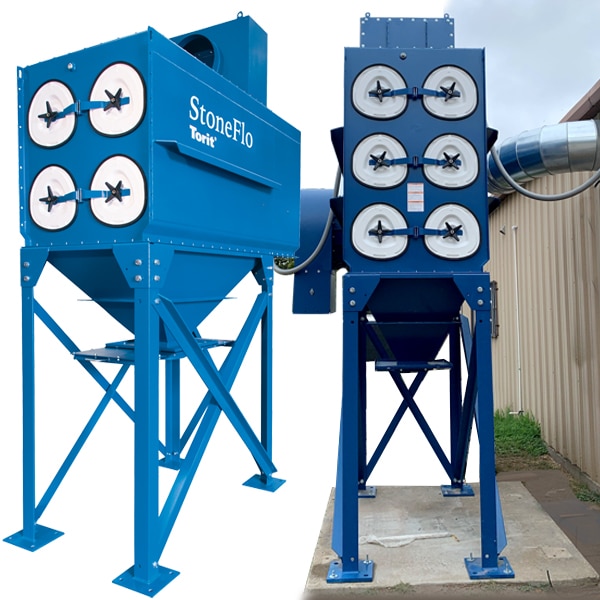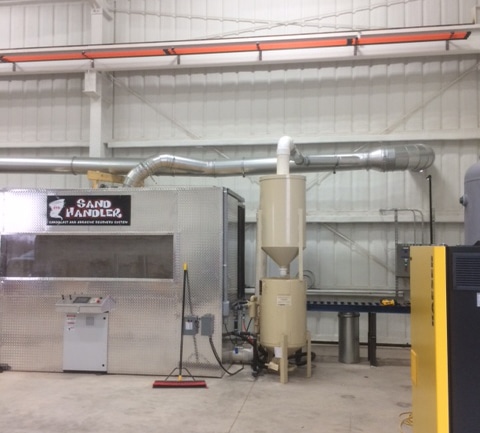Silica Exposure and how dust collectors can help.

We can do a site visit and evaluation to find the best solution; whether it is standard or a custom project. No job too big or small. Request a quote for the Torit StoneFlo equipment that’s right for you.
This information is from our partner Donaldson Torit see their webpage.
New Exposure Limits
The OSHA rules impose updated requirements for exposure assessment, respiratory protection, medical surveillance, hazard communication and record keeping. They also cut the permissible exposure limit (PEL) in half, to no more than 50 micrograms per cubic meter (µg/m). If the airborne concentration of silica exceeds 25 µg/m over eight hours, the employer is required to take actions to reduce potential exposure.
The Role of Dust Collection
Designed and maintained properly, a dust collection system can help reduce the amount of airborne dust as part of a larger mitigation strategy. Local exhaust ventilation systems (silica dust collection) is named as one engineered control in the OSHA standards.
Defining an Effective System – Silica dust control goes beyond merely having a dust collector. It requires the management of three important “E’s” at different points in the facility (Illustration 1):
- Exposure: Reducing dust concentrations within the ambient air around employees;
- Efficiency: Filtering the captured dust with dust collector technology tailored to the application; and
- Emissions: Minimizing the amount of dust exhausted into the atmosphere.
Illustration 1: Effective dust control means managing three “E’s” at different points in the facility: Exposure, Efficiency, and Emissions. The performance of the hood defines the maximum achievable performance of the dust control system as a whole. If the hood captures only 20% of the dust, the local exhaust ventilation system will only be 20% effective.
Mitigation Measures
OSHA has published a number of guides to help employers in various industries understand and comply with the new rules. The strategies listed for managing silica exposure include these common ones:
- Work practice and procedural changes: Modifying processes to reduce dust volumes, and/or limiting access to high-exposure areas;
- Engineered controls: Containing the dust with barriers, enclosures, or wetting, and/or capturing it with local exhaust ventilation; and
- Personal protective equipment (PPE): Providing a full-face respirator approved by the National Institute for Occupational Safety and Health (NIOSH), if other controls are inadequate or in the process of being installed.
Design and Compliance expertise are crucial see bottom of page.
Critical Components
To address all three zones, an effective dust collection system includes well-designed hoods and ducts that maintain recommended capture and conveying velocities; efficient dust collection technology; fans sized appropriately for the system airflow and pressure design requirements; and appropriate work practices to manage the dust and maintain the system. Here is more detail:
#1: Hood’s Design and Placement

Note that our SandHandler system ducts directly out to the Torit dust collector. See SandHandler sandblast & abrasive recovery system.
#2. Duct Air Flow
Maintaining recommended capture and conveying velocities for various dust is also critical. Heavy or toxic dusts require higher capture velocities to draw particulate into a hood, as well as higher conveying velocities to pull dust through the duct system to the dust collector. A qualified industrial ventilation designer should advise on the initial lay-out and on any remodeling of ventilation systems. Adding a hood or duct can throw off the delicate balance of air flow within the system.
#3: Collector Efficiency
A dust collector should effectively remove dust from the air volume it processes while working in a steady-state condition. With continuous cleaning collectors under stable operating conditions, an accumulated dust cake will be present on the filters. When this cake is dislodged during a cleaning cycle, the dust concentration around the filter will be much greater than the inlet dust load concentration. Because it is difficult to validate the actual accumulated dust load, relying on the theoretical performance efficiency of a new filter (for example, one rated MERV 14) may not be the best indicator of overall performance. Monitoring employee exposure and outlet emissions levels is a better performance indicator.
Design Expertise
Best practices for dust collection design are contained in the Industrial Ventilation Design Manual published by the American Conference of Governmental Industrial Hygienists. A qualified industrial ventilation designer can develop a dust collection system according to these practices. Good design entails drawing sufficient control volume at each exhaust ventilation hood to contain and control the dust at each source. There’s a delicate balance to manage from a design standpoint, and if you try to tap into what’s already there with additional ducts, you can throw that balance off. It’s a good idea to have an industrial designer advise on any remodeling.
Compliance Expertise
Process owners should engage the right experts to advise them on compliance with silica regulations. A knowledgeable employee health and safety (EHS) professional can help interpret exactly which regulations apply and how to best implement them, given the unique aspects of a specific facility and process. A trained industrial hygienist can help test and monitor exposure levels to verify the ventilation system is operating within the design parameters and advise on additional actions or work practices to reduce silica exposure. OSHA also offers an On-site Consultation program for small businesses.
1 Frequently Asked Questions: Respirable Crystalline Silica Rule
2 OSHA Health Effects of Silica
3 Respirable Crystalline Silica Standard for General Industry and Maritime (29 CFR 1910.1053) and Respirable Crystalline Silica Standard for Construction (29 CFR 1926.1153)
4 30 CFR SS56-58; MSHA FAQ on Silica Exposure for Underground Miners
5 OSHA Publications on Crystalline Silica
6 OSHA On-Site Consultation Program

